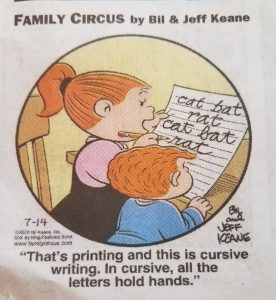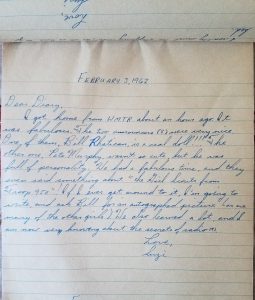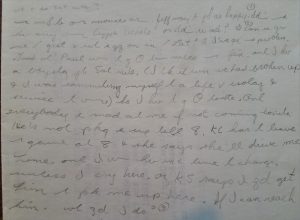Mainly what I remember about learning script was that there were letters I liked and letters I didn't like.
This Family Circus comic was in the newspaper on Tuesday, as I was getting ready to start my story. It was so perfect, I had to make it my featured image.
I remember learning to write in cursive, although nobody ever used that word to describe it. We always called it script. I think it must have been in fourth grade. Since I wasn’t sure, I googled “when is cursive taught in school?” and the answer was “usually in third grade.” But I did second and third grade in one year (as described in What Did You Learn in School Today?) and didn’t fully arrive in the third grade classroom until at least February. If the class had already been learning to write script and I had to catch up, I would certainly remember that, and I don’t have any memory like that. Moreover, I also found online a book entitled Cursive Handwriting Workbook 4th Grade, which says in the product description, “At 4th grade, children are introduced to cursive writing.” This supports my hunch. Interestingly, this book was published in 2016, so apparently there is some demand for it even now.
Mainly what I remember about learning script was that there were letters I liked and letters I didn’t like. I didn’t like the capital F and the capital T, because you had to do them in two parts, the somewhat swoopy horizontal line at the top, and then the part that went down and around, which I thought was kind of ugly. I disliked the capital Q even more, because it just looked like a big 2, which seemed ridiculous. I liked the capital S, which was a good thing since it was at the start of my name and I had to write it a lot. I was glad I didn’t have a name that started with F or T or Q. All the lower case letters were fine, except that I didn’t like the way the v and the w connected to the next letter at their top instead of their bottom. But despite my feelings about the various letters, I learned them all, and wrote them correctly, as you can see by this page from my diary in sixth grade. (You will have to click on it if you actually want to read it.)
My sixth grade handwriting stayed pretty much the same until ninth grade. That year we had a required Business class instead of Science. Despite the fact that we were a college-prep high school, this was how the curriculum had been set up. It would have made more sense to have the Business class in eighth grade and the Science class in ninth grade, since colleges only looked at ninth through twelfth grade subjects, but they didn’t do it that way. We did learn a lot of useful things in the Business class, including how to touch type, how to invest in the stock market, and – relevant to this story – how to write in StenoScript, a type of alphabet shorthand. None of us were planning to be secretaries, or ever have to take dictation, but it was extremely useful for taking notes in class. All my class notes from high school and college are written in StenoScript.
In order to be fast, there were lots of shortcuts. The letter j stood for “tion” at the end of a word. A capital O meant “out” and a capital S was “st.” Other strokes stood for other letter combinations. Another time-saving measure was to omit the dots on the letters i and j, and the crossbar on the letter t. To this day, I never do the dots when I am writing (or printing) anything. I do cross my t’s though, because otherwise it could be a tall i or a short L. To give you an idea of how a page of StenoScript looked, here is a document I discovered tucked into my high school yearbook. My friend Joanie and I were writing notes to each other in StenoScript. I know it was in senior year, because in the next section I give a plot synopsis of the page of the Aeneid that we were reading in Latin class, and she talks about driving herself somewhere. I can actually still understand all of it! (Again, click on it to make it large enough to see.)
At some point, while I was still using the StenoScript abbreviations, I switched from pure cursive to a hybrid of printing and writing, which I still use today. The letters are still holding hands (as Dolly says in Family Circus), but they are mostly the printed forms of the letters rather than the cursive ones. Eventually it got to the point that the only time I used pure cursive was in writing checks. I made out the entire check that way – the date, the payee, and the amount, as well as the signature. At some point when I had a really long payee name (like two different people, or a business with a complicated name), or a dollar amount that had many digits to be written out, I realized I could fit more on the line if I printed than if I used cursive. So eventually I started printing everything except my signature. Not that I write checks very often any more, but when I do, only my signature is in cursive. (Although now that I have written this story, I may go back to using all cursive on my checks.) All the other places that signatures are required nowadays, like on touchpads at stores, it is so difficult to write a decent signature that mine has now devolved into a bunch of squiggles, with only the first letter of each name actually formed.
I am sorry that script, or cursive, or whatever you choose to call it, is now disappearing, even though I am one of the offenders. Everyone’s handwriting is distinctive, in a way that printing usually is not. As I said in an earlier story, Please Mr. Postman, looking at old handwritten letters or even just the envelopes is so enjoyable, and brings back memories of the person who wrote them purely from their handwriting, even before reading what they actually wrote. And it is sad that we are losing that. Or have already lost it.






Oh Suzy, I’m amazed at your recall and at your saved sixth grade diary, and the cryptic note to your friend Joanie!
Altho I have no memory of learning cursive – which yes we called script – I obviously did as I always use it.
And although I remember little of what I learned in high school (like Simon & Garfunkel!) I did learn to type, which like riding a bike somehow enters one’s muscle memory!
But alas I have little memorabilia from my childhood. I was in my 30s when my parents sold the house I grew up in, and I don’t even remember them offering me any of my old toys or books or letters – , perhaps they knew I was an unsentimental thrower-outer so they didn’t bother!
I did however save some of my son’s childhood memorabilia (see Aruba Nights, Baby Shoes) so I guess I’m not completely heartless!
Both the diary and the note were things I stumbled on very recently and had no idea I had saved. Finding the diary (written on a regular 8×11 tablet) was amazing, but frustrating too because I only wrote in it for a month and then stopped suddenly, having written the date and Dear Diary but nothing more. The note with Joanie was tucked in the back of my yearbook, and I wish that I had tucked more things back there!
Altho you found them by serendipity Suzy, It’s still amazing that you still had them to find!
And I bet you still have your college and grad school papers, mine surely are on the dustheap of history!
Still have a few college papers, and my senior honors thesis that I wrote on the McCarthy campaign. But in law school everything we wrote was way too boring to keep!
Suzy, I LOVE your “Family Circus” cartoon Featured Image. What a nice way to describe cursive! Interesting about learning cursive in 4th grade because I distinctly remember the teacher who taught it to me and she taught the first half of 2nd grade (Mrs. Kutnick, an older Jewish woman who was not kind and made me very anxious; I was SO happy to have my beloved Mrs. Zeve for a whole year; 2A and 3B). My kids learned it in FIRST grade when manual dexterity is even less-well developed.
Your StenoScript is fascinating. You are right. It makes so much sense for quick note taking (that is when all our writing falls apart, as we need to be quick). Thanks for the explanation and example. It clearly served you well!
In my story, I give everyday examples of continuing to use cursive, but forgot about check writing (which I still do occasionally too). That’s a good one. Thanks for your interesting story.
Thanks, Betsy. The timing on that cartoon was so perfect, I couldn’t believe it. Then when I went online to see if I could get a cleaner image than the one in the paper, I saw all sorts of comments about how unrealistic it was that Dolly and Jeffy would care about cursive, which no kids their age would know.
My husband still gives me grief about not dotting my i’s, claiming that it makes my writing hard to read (mainly on grocery lists), but there’s no way I can change that habit now. He should be happy that I cross my t’s!
What an amazing deep dive into cursive — or script as you call it (as did I when learning it). I particularly enjoyed your talking about letters that you liked and didn’t like, as I had completely forgotten that I had had the same reactions as well when learning. Indeed, like you, I thought the capital Q was the stupidest letter imaginable.
I also particularly enjoyed your discussion and illustration of StenoScript. Again, it rang a bell for me: all those ads in NYC subway cars for years for shorthand courses. (I am sure that StenoScript format did not prescribe writing “if u cn read this….”, but still….)
And I agree with you about the lovely connectivity one has/had with a letter sender as soon as you recognize the handwriting, no matter how difficult it is to read. Sure, it is nice to see the name of a friend pop up in one’s email in-box, but it’s just not the same.
Finally, what a perfect, sweet cartoon you found and amazing that it was just published.
Thanks, John. Glad to hear that you called it script too. “Cursive” is such a weird word, and it kinda sounds like “cursing” so not a good word for a small child to hear. I wonder when the switch of name occurred.
I remember seeing those ads on the NY subway cars too, but I’m not sure what method they were promoting. I don’t think it was shorthand, I think it used the alphabet, so maybe something similar to StenoScript.
I wrote that whole story in January about the magic of letters, and went back to re-read it when I was writing this one. It’s sad that we don’t have that any more, although on the other hand, getting an immediate response by email or text has its own advantages.
Love, love, love this story! How perfect that you came across that cartoon, Suzy…it not only suits your wonderful story in subject matter but in content and tone as well. As a former “steno,” I’m fluent in shorthand (and even machine shorthand, as a court reporter) but somehow have never heard of StenoScript. I love it! And of course I love that you have your memorabilia to back it up. (After a family vacation in my teens during which I enjoyed a very steamy night with the boy in the family we were camping with, I wrote it all down in shorthand…and I still have it, of course. And it’s still blushworthy!) I love that you signed off “Love, Suzi” in your diary. And you crack me up (again!) with your likes and dislikes of certain letters…that is SO you! And again I have to compliment your engaging writing style. Lots of love this and love that in this comment, I know, but there you have it.
Thank you for your exuberant comment, Barb, I love it! I actually was thinking of you and your court reporting story when I was writing about StenoScript. Which is nothing like machine shorthand, I realize, but my brain made that connection. And how fun that you can still read your blushworthy shorthand notes about your steamy night – much better than my description of the Aeneid!
I once had another diary which I wrote to as Dear Kitty, just like Anne Frank did. Not sure if that was before or after this one, and I don’t seem to have it any more (although it could still turn up in a box at some point). In this one I just wrote Dear Diary, but of course I signed it Love, Suzi because I thought of it as a letter to this person called Diary.
I’d forgotten about the individual script letters, Suzy, and this story made me grin from ear to ear! I use my cursive signature (mostly), and it’s interesting how we both evolved our writing to print. It is distinctive. I’d blocked out shorthand and never heard of your variety because I knew I might have to start my career doing secretarial work (which I did), and although I typed well, I drew the line at learning shorthand.
Wow, Marian, I love it that my story made you grin from ear to ear! That is high praise indeed! Your sample of your “cursive compromise” in your story (which I will comment on directly) is very similar to mine, except that you dot your i’s.
Wish I had learned steno script, Suzy. I just love your sixth grade diary and the fact that you still have it. I think teaching cursive in 4th grade makes sense because kids have better fine motor skills by then. Like you, I think the fancy cursive capital letters are weird and usually use a printed version of them. For me, the issue has more to do with young kids not being able to read cursive at all. That’s a great loss.
Of course if you had learned StenoScript and used it to take notes in college, Fred couldn’t have borrowed your notes in that course you took together, and you might never have married him! And yes, I understand your issue about young kids not reading cursive, and I agree with you.
Suzy, I loved the list of attitudes you developed about letters and the many rationales you were able to recall about why you did or did not like certain letters. I do remember I harbored a certain amount of contempt for Q as well. I thought, well, they just used that 2 because they couldn’t come up with anything better.
I recall having a complex set of opinions about numbers as well. Certain multiplication tables like X 9 just seemed to generate cooler numbers than others.
I also loved reading your diary. You certainly had some pretty zippy opinions about the boys in your world ;-). I thought this story was quite sweet and intimate, as if you were sitting across the table from your reader, having a cup of coffee or a glass of wine. Or maybe, back then, a coke!
Thanks for your comment, Charlie. Seems that nobody liked the capital Q! And yes, there are certain numbers that are just cooler than others as well. Did you love the way I referred to one of the announcers at the radio station (an adult man, not a boy) as “a real doll”? And the other man was not as cute, but “full of personality”? I don’t know where I got those expressions from at that age! I like your comment about sitting across the table from the reader, but I have never liked coke, so it would have had to be root beer!